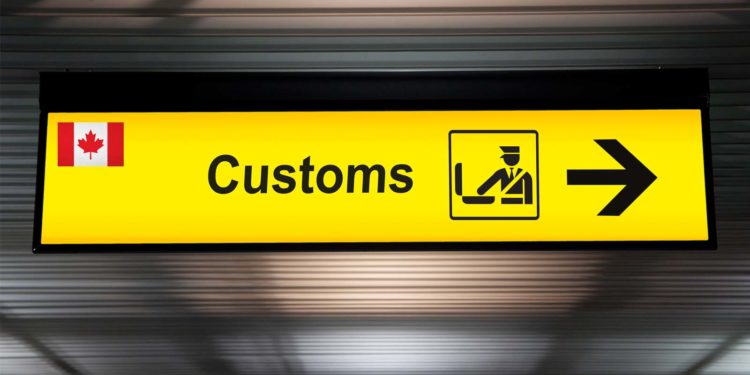What You Need to Know about CANPASS for Business Aviation – Part 1: What is CANPASS

This business aviation blog post is part one in a two-part series on CANPASS regulations.
The Canadian Passenger Accelerated Service System (CANPASS) is a series of Canada Border Service Agency (CBSA) programs to expedite the border clearance process for frequent, low-risk, pre-approved travelers into Canada. If you fly your business aircraft to Canada frequently from the U.S., membership in CANPASS’s corporate aircraft program allows faster access to a wider selection of airports.
The following is an overview of what you need to know:
1. How arrivals are reported in Canada
Telephone reporting is the system used by general aviation to report to customs when entering Canada. This process is also used by participants in CANPASS private aircraft and CANPASS corporate aircraft programs. The reporting process is considered to meet all requirements for “presentation of persons on arrival in Canada,” as required by section 11 of the Customs Act. To set up arrival clearance, the pilot calls 1-888-CANPASS at least two hours prior to arrival and no more than 48 hours prior to the Estimated Time of Arrival (ETA).
2. How CANPASS private and corporate aircraft programs work
CANPASS private aircraft and CANPASS corporate aircraft programs expedite the border clearance process and allow access to airports not available to non-CANPASS members. Under these programs, you can land at any Airport of Entry (AOE) in Canada, anytime the airport is open for landing, and you may land at authorized CANPASS-only airports that may be closer to your destination. To benefit from CANPASS private or corporate aircraft privileges, 1) membership is required, 2) the aircraft may not carry more than 15 people, including crew, and 3) the pilot must ensure all travelers have appropriate travel documents.
3. How CANPASS private aircraft and corporate aircraft programs differ
Under the CANPASS corporate aircraft program, operators may transport up to four non-members who are integral to the business operation of the company, such as an executive. CANPASS corporate aircraft membership, however, cannot be applied to charter (non-scheduled commercial) flights. Family businesses may use the corporate aircraft program, as long as the business which owns the aircraft is incorporated. Up to four non-CANPASS members may be transported, so long as at least one CANPASS holder is onboard, and non-registered passengers can demonstrate a work-based relationship with the corporation and are able to meet the same citizenship and residency requirements as program members. CANPASS private aircraft program is more restrictive in that it requires all passengers onboard to be CANPASS members.
4. Special benefits that CANPASS members have
CANPASS holders may land at an AOE any time the site is open, regardless of the hours of the local customs office, so long as it’s approved by CANPASS. In addition, CANPASS holders may choose to use any designated CANPASS-only airport. Those using CANPASS private or corporate aircraft programs may proceed directly to their destination (without calling 1-888-CANPASS on landing) if there’s no CBSA officer waiting at their reported time of arrival. Keep in mind that any change in ETA of 30 minutes of more should be advised prior to landing.
5. Qualifying for a CANPASS permit
A CANPASS permit is applied for directly with CBSA and usually takes two to three weeks to process. Permit validity is one year, and then you’ll go through the process again. To be eligible for a CANPASS private aircraft, you must be a citizen of Canada or the U.S. or have lived in Canada or the U.S. continuously for the past three years. You must be admissible to Canada under applicable immigration laws and have provided true and accurate information on the application. You must not be in violation of any customs or immigration legislation, have not had a customs seizure within the past five years and have not been convicted of a criminal offense for which a pardon or rehabilitation has not been granted. For CANPASS corporate aircraft, you must also demonstrate a work-based relationship with the corporation. CANPASS permit holders must have CANPASS IDs with them when flying into Canada.
6. Differences between regular CANPASS airports and CANPASS permit-only airports
So long as telephone reporting has been accomplished at least two hours in advance, anyone can clear customs at a regular CANPASS airport. However, you must arrive during CBSA hours of operation, unless you’ve been pre-approved to land after-hours or qualify for CANPASS corporate or private aircraft programs. CANPASS permit-only airports may only be used under the CANPASS private aircraft program if all onboard are CANPASS members arriving from the U.S. With the CANPASS corporate aircraft program, you may land at CANPASS permit-only airports from any international destination with up to four eligible non-CANPASS permit holders onboard.
7. Crew and passenger visa requirements for entering Canada
Visa requirements depend on the nationality and particulars of your flight. Passengers and crew members requiring visas must obtain visas in advance of arrival. Visas are required even for international tech stops, but certain exemptions exist for people transiting to or from the U.S. with valid U.S. visas. Additional visa exemptions exist, particularly when transiting Canada on tech stops, but it’s best to confirm that with your 3rd-party provider due to possible changes in requirements. (For Canada visa requirements, see: http://www.cic.gc.ca/english/visit/visas.asp)
Conclusion
It’s important to keep in mind that if there are more than four non-CANPASS holders onboard, you may not use the CANPASS corporate aircraft program. If an individual receives a temporary authorization to travel on a declared CANPASS corporate flight, a CAN$25 fee (per person) will apply each time they enter Canada – regardless of AOE or whether a customs officer is present.
Questions?
If you have any questions about this article or about Canadian customs requirements, contact me at adamhartley@univ-wea.com.
Later we’ll discuss using CANPASS for your travel to Canada.




